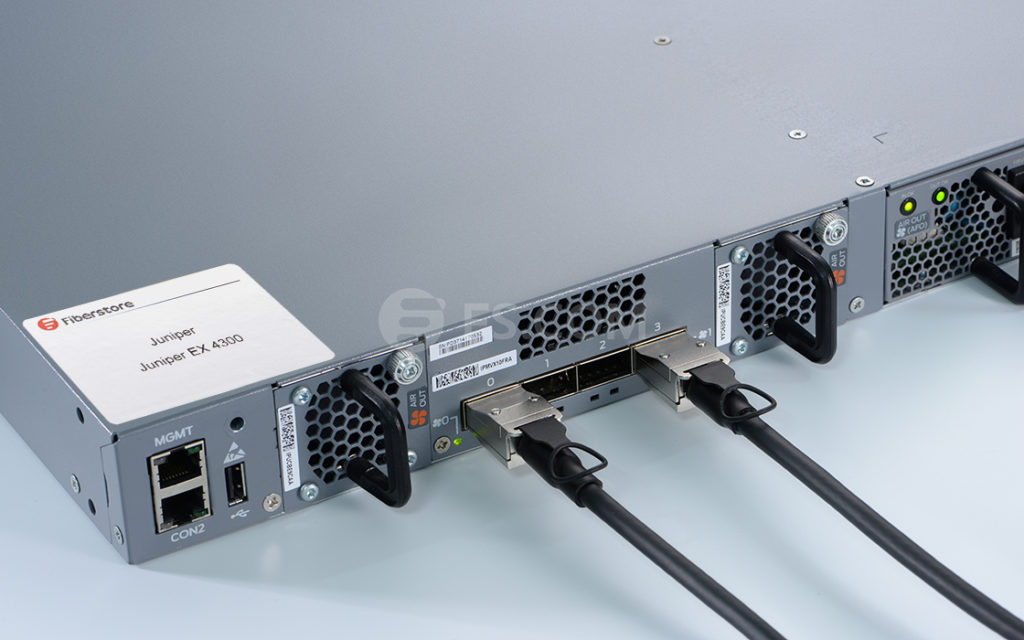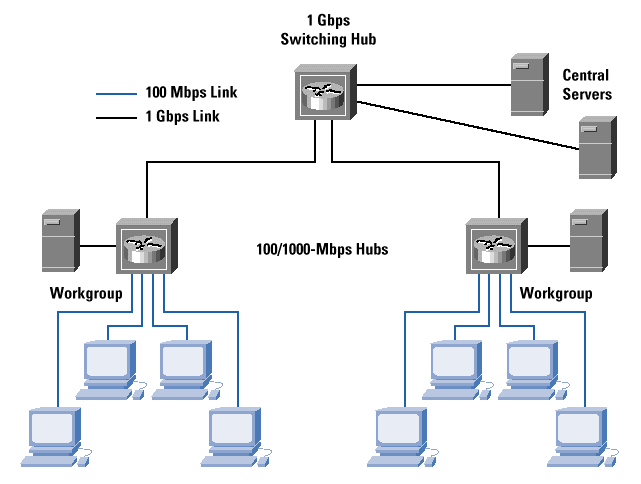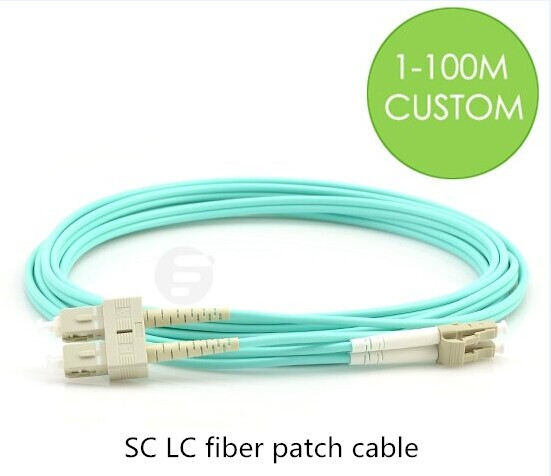September 29, 2016
Quad small form-factor pluggable plus (QSFP+) direct attach copper (DAC) cables are cables with QSFP+ module at one end or both ends. They are suitable for in-rack connections between QSFP+ ports of EX Series switches. They are suitable for short distances of up to 10 meters, making them ideal for highly cost-effective networking connectivity within a rack and between adjacent racks. This article will introduce EX Series switches and QSFP+ DAC for EX Series switches.
EX Series switches deliver scalable port densities and carrier-proven high availability features that consolidate legacy switch layers, helping to reduce capital and operational expenses and advance the economics of networking. For example, the EX 4200 series Ethernet switches with Virtual-Chassis technology, deliver the same Gigabit Ethernet (GbE) and 10GbE port densities as traditional chassis-based switches, but at one-eighth the footprint and less than one third the cost. The EX Series switches are right-sized for campus, data center and remote office environments and feature many of the same carrier-class hardware and software architectures found in core routers that were purpose-built to support the convergence of data, voice, and video onto a single always-on network.

By alleviating the cost, complexity and risk associated with legacy switch infrastructures, the EX Series switches enable high-performance businesses to deploy a high-performance network infrastructure based on three key tenets – operational simplicity, carrier-class reliability, and integration and consolidation – to enable ubiquitous access to strategic assets, reduce network downtime and enhance overall security to shared assets across the extended enterprise.
QSFP+ direct attach copper (DAC) cable is hot-removable and hot-insertable. QSFP+ DAC mainly has two kinds. One is a cable that connects directly into two QSFP+ modules, one at each end of the cable. The cables use integrated duplex serial data links for bidirectional communication and are designed for data rates up to 40 Gbps. The other is a breakout cable consisting of a QSFP+ transceiver on one end and four SFP+ transceivers on the other end. The QSFP+ transceiver connects directly into the QSFP+ access port on the QFX Series device. The cables use high-performance integrated duplex serial data links for bidirectional communication on four links simultaneously. The SFP+ links are designed for data rates up to 10 Gbps each.
The following table describes the software support for QSFP+ passive DAC cable lengths on EX Series switches for Junos OS releases.
|
Switch |
Software Support Added |
DAC Model Number |
|---|---|---|
|
EX44300 switches |
Junos OS for EX Series switches, Release 13.2X51-D15 or later |
|
|
EX4300 switches |
|
|
|
EX4550 switches |
|
|
QSFP+ direct attach copper cables can provide cost-effective and reliable 40G speed connections for EX Series switches with distances reaching up to 10 meters. As the leading fiber optical manufacturer in China, FS.COM offers various types of QSFP+ DAC with low cost but high performance. Apart from the above-mentioned, FS.COM offers Cisco QSFP+ breakout cable as well. All these DACs are with 100% compatibility and can be customized according to your particular needs.
Posted by: jowang at
03:50 AM
| No Comments
| Add Comment
Post contains 590 words, total size 8 kb.
September 13, 2016
Gigabit Ethernet technology is an extension of the 10/100-Mbps Ethernet standard, providing a raw data bandwidth of 1000 Mbps while maintaining full compatibility with the installed base of over 70 million Ethernet nodes. A Gigabit Ethernet is imperative for two reasons: faster systems and faster backbones. Gigabit Ethernet has the potential for low-cost products, freedom of choice in selecting the products, interoperability, and backward compatibility. Gigabit Ethernet supports existing applications, network operating systems, and network management; it requires a minimal learning curve for Ethernet network administrators and users. These investment preservation and risk minimization aspects are what make Gigabit Ethernet so attractive. With the development of Ethernet systems and the growing capacity of modern silicon technology, embedded communication networks are playing an increasingly important role in embedded and safety critical systems.

A known type of data communication device is a small form factor pluggable (SFP) module. Typically, the SFP module plugs into an interface slot in a circuit board populated with other communication devices used in an Ethernet-based system. The SFP module includes a second serial interface, interconnected with the circuit board slot, and a first serial interface, coupled to a serial link, such as a copper or fiber link, for communicating with remote link partners. The serial link, coupled with the first serial interface, may be a 10/100/1000 Base-T copper link, or a fiber link, for example. The SFP module also offers several significant advantages over its predecessor, the GBIC (Gigabit Interface Converter), including lower cost, lower power, and smaller size. Thus, with the SFP form factor, fiber Gigabit systems may be developed featuring similar port densities as copper-only systems using RJ-45 connectors.
The SFP transceiver Multi-source Agreements (MSA) document puts forward a specification for the development of optical SFP modules based on IEEE 802.3z, the Gigabit Ethernet Standard. Specifically, the MSA calls out 1000Base-X Physical Coding Sub-layer (PCS) which supports full-duplex binary transmission at 1.25 Gbps over two copper wire-pair SerDes (Serializer/Deserializer). Transmission coding is based on the ANSI Fiber Channel 8B/10B encoding scheme.
1000Base-X makes no provision for running at slower speeds. Thus, network device ports utilizing SFPs are dedicated to operating on fiber links at speeds of 1000 Mbps. However, more than 85% of office space inside buildings is category 5 copper. Thus, ports designed to use optical SFPs can not make use of this existing cabling.
For example, a customer may require a network device, such as a router, having both optical ports for long distance connections and RJ-45 copper ports for connecting to local devices. It is often the case that not all optical ports provided on a router are needed at a given time. However, with conventional SFPs these optical ports cannot be utilized to connect with local devices connected by standard copper cabling or operating at speeds lower than 1000 Mbps. But with a 1000BASE-T copper SFP transceiver, the customer could use their existing copper cabling infrastructure instead of replacing the infrastructure. Here are two good examples of 1000BASE-T SFP transceivers, the Finisar FCLF-8521-3 compatible 1000BASE-T SFP copper transceiver and Cisco Linksys MGBT1 compatible 1000BASE-T SFP copper transceiver from FS.COM. Both of them are designed for 100m reach over Cat 5 UTP cable with RJ-45 interface and support max data rate of 1000Mbps.
The 1000BASE-T copper SFP transceiver offers a flexible and simple method to be installed into SFP MSA compliant ports at any time with no interruption of the host equipment operation. It enables for seamless integration of fiber with copper LAN connections wherever SFP interface slots can be found. Such system is economical, it saves time, offers flexibility and eliminates the necessity for replacing entire devices once the customers have to change or upgrade fiber connections and you will benefit so much from it.
Posted by: jowang at
04:28 AM
| Comments (4)
| Add Comment
Post contains 630 words, total size 5 kb.
September 08, 2016
As audio and video technologies continue to evolve, AV systems are continuously challenged with supporting high resolution video, audio, and control signals. The combination of light and glass presents some unique properties that give AV professionals powerful tools in common AV applications. A fiber optic cable can be used to send high resolution video, audio, and control signals on a single fiber over 30 km (18.75 miles), and avoids the risk of signal loss or degradation, ground loop hums, and electrical interference. Because transmission of content is inherently secure and immune to outside interference, fiber applications are favored in government, military, and medical environments. This article will mainly introduce four advantages of the installation of fiber optic cables in AV applications.
Fiber optic cables are low-loss channels that enable transmission of high resolution video, audio, and control signals over long distance. Losses in fiber optic cables are 0.2 to 3.5 dB/km, compared to 60 dB/km for legacy RG6 coaxial cable at 100 MHz. The low-loss nature of single-mode fiber cables can enable transmission of WQXGA 2560x1600 video signals up to 30 km. Due to these advantages, fiber optic cables are widely used in campuses, sports stadiums and large office buildings, etc. Besides, installing fiber optic cables with extremely high bandwidth can ensure that future applications can be addressed with today’s fiber installations.
Fibers consume very little space in conduit and cable trays, and are easy to pull. For example, duplex fiber optic cable can transmit high resolution video signals but is only a fraction of the size of a coaxial cable. Because of fiber optic cables’ small size, the installation is much easier especially in medical applications where there is often insufficient space for thicker cables. Besides, today’s field termination kits make fiber easier to terminate than other types of cabling. Simply striping, cleaving, and inserting fibers into fiber optic connectors, you can get a high quality, reliable splice in minutes. And you can also choose pre-terminated fiber cables, such as LC patch cable or SC LC fiber patch cable (as shown below). The connectors you specify are pre-terminated for you, and the fiber cables you specify are cut to the proper length that you need. When the installation is over, you can just plug and play fiber optic system.
Unlike copper cables, fiber optic cables are largely comprised of glass, which does not carry electrical current, radiate energy, or produce heat or sparks. So they can be safely installed in hazardous environments, such as oil refineries, mining operations, or chemical plants, without the danger of generating an electrical spark. Applications using sensitive electronics, such as medical environments, also benefit from the lack of electrical emissions with fiber optic systems. Fiber optic applications have helped the medical field advance tremendously over the past decade. They not only allow the physician to see inside specific areas of the body and perform surgery on hard-to-reach areas, but also provide a quicker and more accurate analysis of blood work.
Fiber optic systems may provide a lower total cost of ownership over the life of the system when compared to a coaxial or twisted pair solution. In copper systems, old cables need to be removed and new cables to be pulled for each system upgrade. While fiber optic cables with high bandwidth can be reused through multiple system upgrades. In addition, fiber optic cables typically consume less power and produce less heat than copper wires, thus reducing both electrical and cooling costs. Moreover, fiber optic systems can be monitored and serviced from the main equipment room without disrupting activities in work areas.
Fiber optic cables provide unique advantages in an AV system, particularly in secure and long distance applications. Choosing the proper cable depends upon the number of fibers required, installation location, topology, and the overall design of the system. Cable constructions are available for both indoor and outdoor applications to provide a solution for virtually any AV system.
Posted by: jowang at
08:52 AM
| No Comments
| Add Comment
Post contains 683 words, total size 5 kb.
34 queries taking 0.0621 seconds, 75 records returned.
Powered by Minx 1.1.6c-pink.










